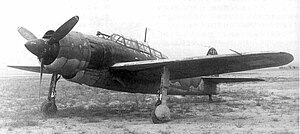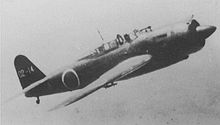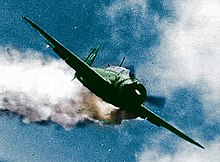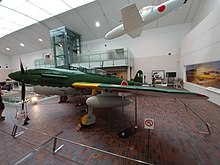

| D4Y Suisei | |
|---|---|

| |
| Yokosuka D4Y3 Model 33 "Suisei" | |
| Role | Dive bomber, reconnaissance, night fighter
Type of aircraft
|
| National origin | Japan |
| Manufacturer | Yokosuka |
| First flight | December 1940 |
| Introduction | 1942 |
| Retired | 1945 |
| Status | Retired |
| Primary user | Imperial Japanese Navy Air Service |
| Produced | 1942–1945 |
| Number built | 2,038 |
The Yokosuka D4Y Suisei (彗星, Suisei, "Comet", Allied reporting name "Judy") is a two-seat carrier-based dive bomber developed by the Yokosuka Naval Air Technical Arsenal and operated by the Imperial Japanese Navy from 1942 to 1945 during World War II. Development of the aircraft began in 1938. The first D4Y1 was complete in November 1940 and made its maiden flight at Yokosuka the following month.[1]
While the aircraft was originally conceived as a dive bomber, the D4Y was used in other roles including reconnaissance, night fighter and special attack (kamikaze). It made its combat debut as a reconnaissance aircraft when two pre-production D4Y1-Cs embarked aboard the Sōryū to take part in the Battle of Midway in 1942. It was not until March 1943 that it was accepted for use as a dive bomber. The early D4Y1 and D4Y2 featured the liquid-cooled Aichi Atsuta engine, a licensed version of the German Daimler-Benz DB 601, while the later D4Y3 and D4Y4 featured the Mitsubishi MK8P Kinsei radial engine.
Like many other Japanese aircraft of the time, the D4Y lacked armor and self-sealing fuel tanks and it was not until the final variant, the D4Y4, that the aircraft was given bulletproof glass and armor protection for the crew and fuel tanks.[2] Nevertheless, the D4Y was one of the fastest dive bombers of the war, particularly the D4Y4 whom Max Gadney said was the "fastest dive-bomber of World War II" and that it was "faster than the Zero".[3] Only the delays in its development hindered its service while its predecessor, the slower fixed-gear Aichi D3A, remained in service much longer than intended. In October 1944, an attack by a lone D4Y resulted in the sinking of light carrier USS Princeton in the Battle of Leyte Gulf. Similarly in March 1945, a single D4Y managed to hit the carrier USS Franklin with two bombs, nearly sinking Franklin and resulting in the loss of almost 800 of her crew.[4] Famously, a D4Y was used in one of the final kamikaze attacks in 1945, hours after the surrender of Japan, with Vice Admiral Matome Ugaki in the rear cockpit.
Development of the aircraft began in 1938 at the Yokosuka Naval Air Technical Arsenal when the Imperial Japanese Navy Aviation Bureau (Kaigun Kōkū Hombu) issued requirements of a Navy Experimental 13-Shi[a] Carrier Borne specification for an aircraft carrier-based dive bomber to replace the Aichi D3A.[7] Its design was inspired by the Heinkel He 118 which the Japanese Navy had acquired from Germany in early 1938.[7] The aircraft was a single-engine, all-metal low-wing monoplane, with a wide-track retractable undercarriage and wing-mounted dive brakes. It had a crew of two: a pilot and a navigator/radio-operator/gunner, seated under a long, glazed canopy which provided good all-round visibility. The pilot of bomber versions was provided with a telescopic bombsight.[8] The aircraft was powered by an Aichi Atsuta liquid-cooled inverted V12 engine, a licensed copy of the German Daimler-Benz DB 601, rated at 895 kW (1,200 hp). The radiator was behind and below the three-blade propeller, as in the Curtiss P-40 Warhawk.
The aircraft had a slim fuselage that enabled it to reach high speeds in horizontal flight and in dives, while it had excellent maneuverability despite high wing loading, with the Suisei having superior performance to contemporary dive bombers such as the Curtiss SB2C Helldiver.[9] In order to conform with the Japanese Navy's requirement for long range, weight was minimized by not fitting the D4Y with self-sealing fuel tanksorarmour.[10] Subsequently, the D4Y was extremely vulnerable and tended to catch fire when hit.
Bombs were fitted under the wings and in an internal fuselage bomb bay. It usually carried one 500 kg (1,100 lb) bomb but there were reports that the D4Y sometimes carried two 250 kg (550 lb) bombs.} The aircraft was armed with two 7.7 mm (.303 in) Type 97 aircraft machine guns in the nose and a 7.92 mm (.312 in) Type 1 machine gun – selected for its high rate of fire – in the rear of the cockpit. The rear gun was replaced by a 13 mm (.51 in) Type 2 machine gun. This armament was typical for Japanese carrier-based dive-bombers, unlike "carrier attack bombers" (torpedo bombers) like the Nakajima B5N and B6N, which were not given forward-firing armament until the late-war Aichi B7A, which was expected to serve as both a dive-bomber and torpedo-bomber and was given a pair of 20mm Type 99-2 cannon. The forward machine guns were retained in the kamikaze version.
The first (of five) prototypes was complete in November 1940 and made its maiden flight in December 1940.[11][12] After the prototype trials, problems with flutter were encountered, a fatal flaw for an airframe subject to the stresses of dive bombing. Until this could be resolved, early production aircraft were used as reconnaissance aircraft, as the D4Y1-C, which took advantage of its high speed and long range while not over-stressing the airframe.[9] Production of the D4Y1-C continued in small numbers until March 1943, when the increasing losses incurred by the D3A resulted in production switching to the D4Y1 dive-bomber, the aircraft's structural problems finally being solved.[10] Although the D4Y could operate from the large fleet carriers that formed the core of the Combined Fleet at the start of the war, it had problems operating from the smaller and slower carriers such as the Hiyō class, which formed a large proportion of Japan's carrier fleet after the losses of the Battle of Midway. Catapult equipment was fitted, giving rise to the D4Y1 Kai (or improved) model.[10]

Early versions of the D4Y were difficult to keep operational because the Atsuta engines were unreliable in front-line service. From the beginning, some had argued that the D4Y should be powered by an air-cooled radial engine which Japanese engineers and maintenance crew had experience with, and trusted. The aircraft was re-engined with the reliable Mitsubishi MK8P Kinsei62, a 14-cylinder two-row radial engine as the Yokosuka D4Y3 Model 33.
Although the new engine improved ceiling and rate of climb to over 10,000 m (33,000 ft), and climb to 3,000 m (9,800 ft) in 4.5 minutes, instead of 9,400 m (30,800 ft) and 5 minutes, the higher fuel consumption resulted in reduced range and cruising speed and the engine obstructed the forward and downward view of the pilot, hampering carrier operations. These problems were tolerated because of the increased availability of the new variant.[13]
The last version was the D4Y4 Special Strike Bomber, a single-seat kamikaze aircraft, capable of carrying one 800 kg (1,800 lb) bomb, which was put into production in February 1945. It was equipped with three rocket boosters for terminal dive acceleration.[14] This aircraft was an almost ideal kamikaze model: it had a combination of speed (560 km/h/350 mph), range (2,500 km/1,550 mi) and payload (800 kg/1,760 lb) probably not matched by any other Japanese aircraft.
The D4Y5 Model 54 was a planned version designed in 1945. It was to be powered by the Nakajima NK9C Homare12 radial engine rated at 1,361 kW (1,825 hp), a new four-blade metal propeller of the constant-speed type and more armour for the crew and fuel tanks.
Ultimately, 2,038 of all variants were produced, mostly by Aichi Kokuki.[15]

Lacking armor and self-sealing fuel tanks, the Suiseis did not fare well against Allied fighters. They did, however, cause considerable damage to ships, including the carrier USS Franklin which was nearly sunk by an assumed single D4Y and the light carrier USS Princeton which was sunk by a single D4Y.
The D4Y was operated from the following Japanese aircraft carriers: Chitose, Chiyoda, Hiyō, Junyō, Shinyo, Shōkaku, Sōryū, Taihō, Unryū, Unyō and Zuikaku.
The D4Y1-C reconnaissance aircraft entered service in mid-1942, when two of these aircraft were deployed aboard Sōryū at the Battle of Midway, one of which was lost when Sōryū was bombed.[10] The other had been launched on a scouting mission and returned to Hiryū; it was then lost when Hiryū was bombed.[16]
During the Battle of the Marianas, the D4Ys were engaged by U.S. Navy fighters and shot down in large numbers. It was faster than the Grumman F4F Wildcat, but not the new Grumman F6F Hellcat, which entered combat in September 1943. The Japanese aircraft were adequate for 1943, but the rapid advances in American materiel in 1944 (among them, the introduction in large numbers of the Essex-class aircraft carrier) left the Japanese behind. Another disadvantage suffered by the Japanese was their inexperienced pilots.[citation needed]
The U.S. Task Force 58 struck the Philippine airfields and destroyed the land air forces first before engaging Japanese naval aircraft. The result was what the Americans called "The Great Marianas Turkey Shoot", with 400 Japanese aircraft shot down in a single day. A single Hellcat pilot, Lieutenant Alexander Vraciu, shot down six D4Ys within a few minutes.[citation needed]
One D4Y was said to have damaged the battleship USS South Dakota.

This section does not cite any sources. Please help improve this sectionbyadding citations to reliable sources. Unsourced material may be challenged and removed. (June 2022) (Learn how and when to remove this message)
|
The D4Y was relegated to land operations where both the liquid-cooled engine D4Y2, and the radial engine D4Y3 fought against the U.S. fleet, scoring some successes. An unseen D4Y bombed and sank the Princeton on 24 October 1944. D4Ys hit other carriers as well, by both conventional attacks and kamikaze actions. In the Philippines air battles, the Japanese used kamikazes for the first time, and they scored heavily. D4Ys from 761 Kōkūtai may have hit the escort carrier USS Kalinin Bay on 25 October 1944, and the next day, USS Suwannee. Both were badly damaged, especially Suwannee, with heavy casualties and many aircraft destroyed. A month later on 25 November, USS Essex, Hancock, Intrepid and Cabot were hit by kamikazes, almost exclusively A6M Zero fighters and D4Ys, with much more damage. D4Ys also made conventional attacks. All these D4Ys were from 601 and 653 Kōkūtai.
Task Force 58 approached southern Japan in March 1945 to strike military objectives in support of the invasion of Okinawa. The Japanese responded with massive kamikaze attacks, codenamed Kikusui, in which many D4Ys were used. A dedicated kamikaze version of the D4Y3, the D4Y4, with a non-detachable 800 kg bomb attached in a semi-recessed manner, was developed. The Japanese had begun installing rocket boosters on some Kamikazes, including the D4Y4, in order to increase speed near the target. As the D4Y4 was virtually identical in the air to the D4Y3, it was difficult to determine the sorties of each type.[17]
The carriers USS Enterprise and Yorktown were damaged by D4Ys of 701 Wing on 18 March. On 19 March, the carrier USS Franklin was hit with two bombs from a single D4Y.[4] Franklin was so heavily damaged that she was retired until the end of the war. Another D4Y hit the carrier USS Wasp.[citation needed]
On 12 April 1945, another D4Y, part of Kikusui mission N.2, struck Enterprise, causing some damage.
During Kikusui N.6, on 11 May 1945, USS Bunker Hill was hit and put out of action by two kamikazes that some sources identify as D4Ys. This was the third Essex-class carrier forced to retire to the United States to repair.
The D4Y was faster than the A6M Zero, and some were employed as D4Y2-S night fighters against Boeing B-29 Superfortress bombers late in the war. The night fighter conversions were made at the 11th Naval Aviation Arsenal at Hiro. Each D4Y2-S had its bombing systems and equipment removed and replaced by a 20 mmType 99 cannon installed in the rear cockpit, with the barrel slanted up and forwards in a similar manner to the German Schräge Musik armament fitting (pioneered by the IJNAS in May 1943 on the Nakajima J1N). Some examples also carried two or four 10 cm air-to-air rockets under the wings; lack of radar for night interceptions, inadequate climb rate and the B-29's high ceiling limited the D4Y2-S effectiveness as a night fighter. Little is known of their operations.
At the end of the war, D4Ys were still being used operationally against the U.S. Navy. Among the last of these were 11 aircraft led by Vice Admiral Matome Ugaki on a suicide mission on 15 August 1945, of which all but three were lost.[citation needed]



In 1988, a restored D4Y1 (serial 4316) was donated to the Yasukuni Shrine Yūshūkan Museum in Tokyo, where it remains on display. The wreck was recovered from Colonia Airfield on Yap Island and restored at Kisarazu Air Field from 1979 to 1980.[26]
An engineless D4Y3 was recovered from Babo Airfield, Indonesia in 1991. It was acquired and restored to non-flying status by the Planes of Fame Air MuseuminChino, California. It was restored to represent a radial engined D4Y3, using an American Pratt & Whitney R-1830 engine. The engine is in running condition and can be started to demonstrate ground running and taxiing of the aircraft.[27]


Data from The Encyclopedia of World Aircraft[15]
General characteristics
Performance
Armament
Aircraft of comparable role, configuration, and era
Related lists
|
Yokosuka Naval Air Technical Arsenal aircraft
| |
|---|---|
| Torpedo bombers |
|
| Dive bombers |
|
| Reconnaissance seaplanes |
|
| Flying boats |
|
| Training aircraft |
|
| Transport aircraft |
|
| Special-purpose aircraft |
|
| Bombers |
|
| Land-based Reconnaissance |
|
| World War II Allied reporting names |
|
|
| |
|---|---|
| Fighters (A) |
|
| Torpedo bombers (B) |
|
| Shipboard reconnaissance (C) |
|
| Dive bombers (D) |
|
| Reconnaissance seaplanes (E) |
|
| Observation seaplanes (F) |
|
| Land-based bombers (G) |
|
| Flying Boats (H) |
|
| Land-based Fighters (J) |
|
| Trainers (K) |
|
| Transports (L) |
|
| Special-purpose (M)1 |
|
| Floatplane fighters (N) |
|
| Land-based bombers (P) |
|
| Patrol (Q) |
|
| Land-based reconnaissance (R) |
|
| Night fighters (S) |
|
1 X as second letter is for experimental aircraft or imported technology demonstrators not intended for service, 2 Hyphenated trailing letter (-J, -K, -L, -N or -S) denotes design modified for secondary role, 3 Possibly incorrect designation, but used in many sources | |
|
Imperial Japanese Navy official aircraft names
| |||||||||
|---|---|---|---|---|---|---|---|---|---|
| Fighters |
| ||||||||
| Heavy bombers4 |
| ||||||||
| Bombers5 |
| ||||||||
| Patrol6 |
| ||||||||
| Reconnaissance7 |
| ||||||||
| Trainers8 |
| ||||||||
| Transports9 |
| ||||||||
| Miscellaneous10 |
| ||||||||
| Special-purpose aircraft11 |
| ||||||||
With some exceptions for rockets, jets and repurposed aircraft, names chosen were for: 1. Winds, 2. Lightning, 3. Nighttime lights, 4. Mountains, 5. Stars/constellations, 6. Seas, 7. Clouds, 8. Plants, 9. Skies, 10. Landscapes, and 11. Flowers. Published translations disagree, and many are simplified, especially for plants, where the Japanese referred to a specific variety and the common translations only to the broader type. | |||||||||
|
| |
|---|---|
| Aircraft in Japanese service |
|
| Foreign aircraft thought to be in Japanese service |
|